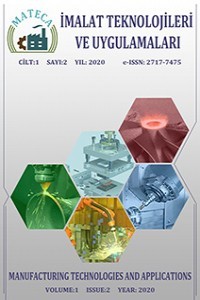Taguchi Metodu ve FEM Analizi ile DD13 Sacların MAG Bindirme Kaynağında Kaynak Parametrelerinin Optimizasyonu
Sonlu elemanlar analizi, Sertlik, Isı girdisi, MAG kaynağı, Taguchi metodu
Optimization of Welding Parameters in MAG Lap Welding of DD13 Sheet Metal with Taguchi Method and FEM Analysis
Finite element method analysis, Hardness, Heat input, MAG welding, Taguchi method,
___
- 1. L. Tang, J. Wu, J. Liu, C. Jiang, W.-B. Shangguan, Topology Optimisation and Performance Calculation for Control Arms of a Suspension, Adv. Mech. Eng. 6 (2014) 734568. https://doi.org/10.1155/2014/734568.
- 2. H.B. Zhang, R.J. Zhang, Y. Chang, Finite Element Analysis of Automobile Suspension Control Arm, Appl. Mech. Mater. 752–753 (2015) 859–863. https://doi.org/10.4028/www.scientific.net/AMM.752-753.859.
- 3. H.B. Zhang, Y. Chang, R.J. Zhang, H.Y. Fan, Reverse Modeling of Vehicle Suspension Control Arm, Appl. Mech. Mater. 427–429 (2013) 1183–1186. https://doi.org/10.4028/www.scientific.net/AMM.427-429.1183.
- 4. B.K. N, Design and Analysis of Sheet Metal Control Arm, Int. J. Sci. Res. 4 (2015) 1241–1248. https://doi.org/10.21275/v4i11.nov151451.
- 5. James D. Halderman, Automotive Steering, Suspension & Alignment, 5. Edition, Pearson, New Jersey, 2010.
- 6. M. Bouazara, Improvement in the Design of Automobile Upper Suspension Control Arms Using Aluminum Alloys, in: Damage Fract. Mech., Springer Netherlands, Dordrecht, 2009: pp. 101–112. https://doi.org/10.1007/978-90-481-2669-9_11.
- 7. M. Shome, M. Tumuluru, Introduction to welding and joining of advanced high-strength steels (AHSS), in: M. Shome, M.B.T.-W. and J. of A.H.S.S. (AHSS) Tumuluru (Eds.), Woodhead Publishing, 2015: pp. 1–8. https://doi.org/https://doi.org/10.1016/B978-0-85709-436-0.00001-1.
- 8. M.A. Wahab, Manual Metal Arc Welding and Gas Metal Arc Welding, in: S. Hashmi, G.F. Batalha, C.J. Van Tyne, B.B.T.-C.M.P. Yilbas (Eds.), Elsevier, Oxford, 2014: pp. 49–76. https://doi.org/https://doi.org/10.1016/B978-0-08-096532-1.00610-5.
- 9. Z. Boumerzoug, C. Derfouf, T. Baudin, Effect of Welding on Microstructure and Mechanical Properties of an Industrial Low Carbon Steel, Engineering. 02 (2010) 502–506. https://doi.org/10.4236/eng.2010.27066.
- 10. P. Kah, R. Suoranta, J. Martikainen, Advanced gas metal arc welding processes, Int. J. Adv. Manuf. Technol. 67 (2013) 655–674. https://doi.org/10.1007/s00170-012-4513-5.
- 11. J. Frei, B.T. Alexandrov, M. Rethmeier, Low heat input gas metal arc welding for dissimilar metal weld overlays part I: the heat-affected zone, Weld. World. 60 (2016) 459–473. https://doi.org/10.1007/s40194-016-0306-z.
- 12. V. Tandon, M.A. Thombre, A.P. Patil, R. V. Taiwade, H. Vashishtha, Effect of Heat Input on the Microstructural, Mechanical, and Corrosion Properties of Dissimilar Weldment of Conventional Austenitic Stainless Steel and Low-Nickel Stainless Steel, Metallogr. Microstruct. Anal. 9 (2020) 668–677. https://doi.org/10.1007/s13632-020-00681-y.
- 13. S. Madhavan, M. Kamaraj, B. Arivazhagan, A comparative study on the microstructure and mechanical properties of fusion welded 9 Cr-1 Mo steel, J. Mater. Res. Technol. 9 (2020) 2223–2229. https://doi.org/https://doi.org/10.1016/j.jmrt.2019.12.053.
- 14. U. Çaligülü, H. Dikbaş, M. Taşkin, Microstructural characteristic of dissimilar welded components (AISI 430 ferritic-AISI 304 Austenitic Stainless Steels) by CO2 Laser Beam Welding (LBW), Gazi Univ. J. Sci. 25 (2012) 35–52.
- 15. S. Selvi, A. Vishvaksenan, E. Rajasekar, Cold metal transfer (CMT) technology - An overview, Def. Technol. 14 (2018) 28–44. https://doi.org/10.1016/j.dt.2017.08.002.
- 16. R. Talalaev, R. Veinthal, A. Laansoo, M. Sarkans, Cold metal transfer (CMT) welding of thin sheet metal products, Est. J. Eng. 18 (2012) 243. https://doi.org/10.3176/eng.2012.3.09.
- 17. M. Grzybicki, J. Jakubowski, Comparative tests of steel car body sheet welds made using CMT and MIG/MAG methods, Weld. Int. 27 (2013) 610–615. https://doi.org/10.1080/09507116.2011.606147.
- 18. M. Korzeniowski, T. Piwowarczyk, P. Kustroń, A. Czubak, Low-Energy Welding Methods Used for Semi-Automatic Thin-Walled Automotive Steels, Adv. Mater. Sci. 13 (2013). https://doi.org/10.2478/adms-2013-0010.
- 19. Y. Liu, L. Zhang, Y. Chen, Application of Cold Metal Transition Technology in Automobile Manufacture, in: Proc. 2018 7th Int. Conf. Energy, Environ. Sustain. Dev. (ICEESD 2018), Atlantis Press, Paris, France, 2018: pp. 1170–1173. https://doi.org/10.2991/iceesd-18.2018.215.
- 20. J. Subramanian, S. Ganguly, W. Suder, D. Mukherjee, Investigation of functional and aesthetic quality of weld for different arc modes in CMT, Int. Res. J. Eng. Technol. 07 (2020) 4497–4502.
- 21. B. Chen, W. Xiao, L. Zhu, F. Zhang, Analysis on the Microstructure and Mechanical Properties of Welding Joint of Low Alloy Structural Steel Plate by Narrow Gap MAG, in: Proc. 2015 Int. Conf. Mechatronics, Electron. Ind. Control Eng., Atlantis Press, Paris, France, 2015. https://doi.org/10.2991/meic-15.2015.21.
- 22. G. Samtaş, S. Korucu, Multiple optimisation of cutting parameters in milling of cryogenically treated Aluminium 6061-T651 alloy with cryogenic and normal cutting inserts, Surf. Topogr. Metrol. Prop. 9 (2021) 045003. https://doi.org/10.1088/2051-672X/ac2796.
- 23. H.R. Ghanbari, M. Shariati, E. Sanati, R. Masoudi Nejad, Effects of spot welded parameters on fatigue behavior of ferrite-martensite dual-phase steel and hybrid joints, Eng. Fail. Anal. 134 (2022) 106079. https://doi.org/10.1016/j.engfailanal.2022.106079.
- 24. A.K. Pattanaik, S.N. Panda, K. Pal, D. Mishra, A Comparative Investigation to Process Parameter Optimization for Spot Welding Using Taguchi Based Grey Relational Analysis and Metaheuristics, in: Mater. Today Proc., Elsevier Ltd, 2018: pp. 11408–11414. https://doi.org/10.1016/j.matpr.2018.02.108.
- 25. G. Samtaş, Optimisation of cutting parameters during the face milling of AA5083-H111 with coated and uncoated inserts using Taguchi method, Int. J. Mach. Mach. Mater. 17 (2015) 211–232. https://doi.org/10.1504/IJMMM.2015.071993.
- Yayın Aralığı: Yılda 3 Sayı
- Başlangıç: 2020
- Yayıncı: Mustafa GÜNAY
Hakan YURTKURAN, Mustafa GÜNAY
Levent UĞUR, Hakan KAZAN, Barış ÖZLÜ
Pnömatik Tahrikli Çekme Yayı Yorulma Makinesi Tasarım ve İmalatı
Fatih ÖZEN, Muhammet Kaan ÇOBANOĞLU, Ahmet İLHAN, Salim ASLANLAR, Hakkı Taner SEZAN
Paslanmaz Çeliklerin Farklı Akımlarda MİG Kaynak Yöntemiyle Birleştirilmesinin İncelenmesi
